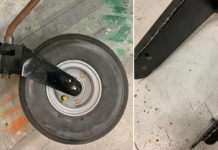A Glasair II-S RG builder with several hundred hours on his aircraft has called my attention to an item on the main landing gear leg, which he feels requires a close inspection. This builder had the left side brace stud break free of the main landing gear trunion. He determined that the weld had failed securing the side brace stud to the trunion. He then inspected the same point on the opposite main landing gear for cracks using a dye penetrant test. The dye penetrant test detected a crack in the weld on this side as well.
Fortunately, in this situation a minimum amount of damage occurred since the aircraft was taxiing.
All Glasair I, and the majority of the Glasair II and some of the III series of RG aircraft, have landing gear trunion with this welded in side brace stud.
The latest production run all the landing gear for the Glasair Super II have been manufactured with a replaceable, hardened side brace stud. This stud is inserted into a threaded opening on the main gear trunion. This unit can be retrofitted to earlier gear trunion with the welded in the stud. This builder elected to retrofit these replaceable studs into both his left and right gear trunion.
It is recommended that all Glasair RG aircraft with the welded in stud inspect this weld area thoroughly for any evidence of cracking.
The procedure necessary to replace the welded in the studs is not particularly difficult. Currently, we do not have instructions completed for this retrofit, but will work with builders, individually if the need arises.



